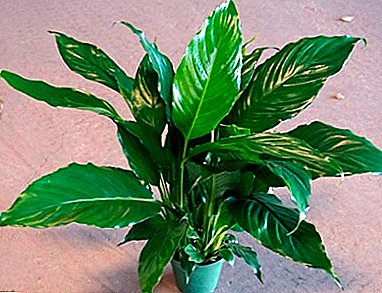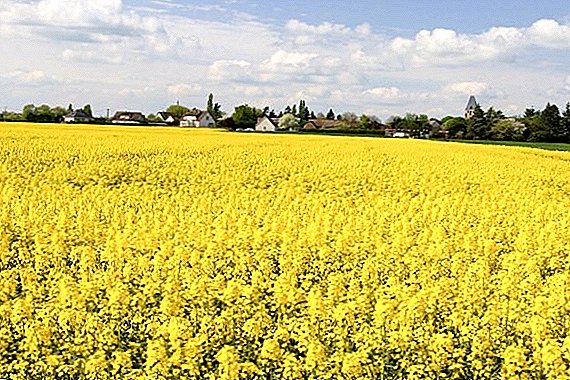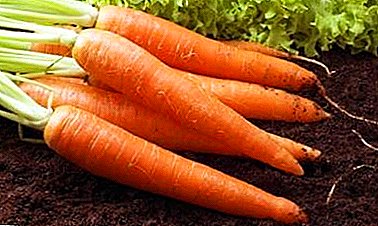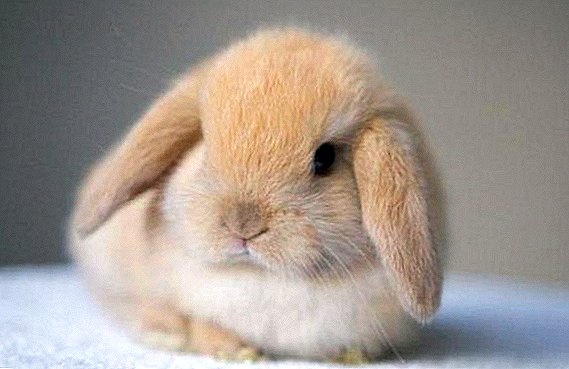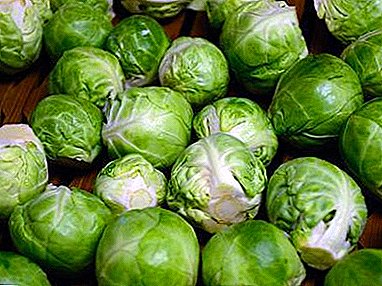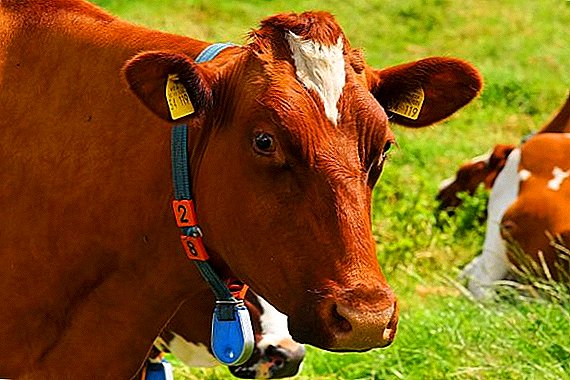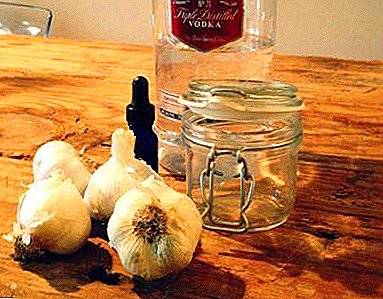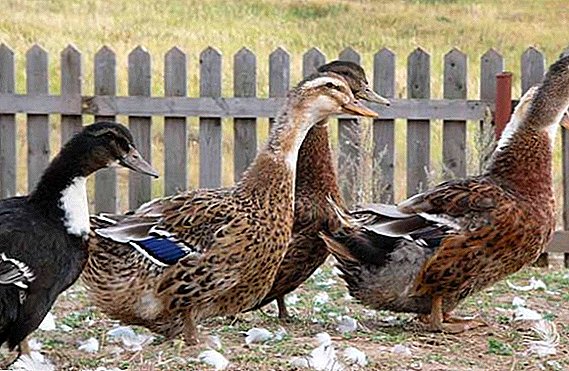 Sometimes the choice of the breed of bird for domestic breeding becomes a problem, because in the world there are about 84. We advise to begin to clearly define the objectives of the content of birds. If the main goal is to get meat, then it is worth choosing from breeds of meat. If you want to get eggs from birds, then you need to look at the egg breeds. Killing two birds with one stone and simultaneously solving two tasks - having eggs and meat - can be achieved by purchasing meat and egg ducks. We have selected for you the breeds that deserve the attention of poultry farmers in each of the areas. Also in the article you will find a description of species of wild and indoutok.
Sometimes the choice of the breed of bird for domestic breeding becomes a problem, because in the world there are about 84. We advise to begin to clearly define the objectives of the content of birds. If the main goal is to get meat, then it is worth choosing from breeds of meat. If you want to get eggs from birds, then you need to look at the egg breeds. Killing two birds with one stone and simultaneously solving two tasks - having eggs and meat - can be achieved by purchasing meat and egg ducks. We have selected for you the breeds that deserve the attention of poultry farmers in each of the areas. Also in the article you will find a description of species of wild and indoutok.
Types of domestic ducks
The most popular among poultry farmers are meat and meat and egg ducks. It is believed that the content of the egg - it is unprofitable. And not everyone likes to eat duck eggs, they are, so to speak, an amateur.
Meat
The best birds in this category today are birds of the breeds:
- Bashkir;
- Beijing;
- Mulard;
- Favorite blue;
- Gray Ukrainian.
These breeds differ from each other in external signs, anatomical structure, color of plumage and level of productivity.
Bashkir duck
Has a strong constitution with a prominent forward breast. The body is located on strong, widely placed paws. 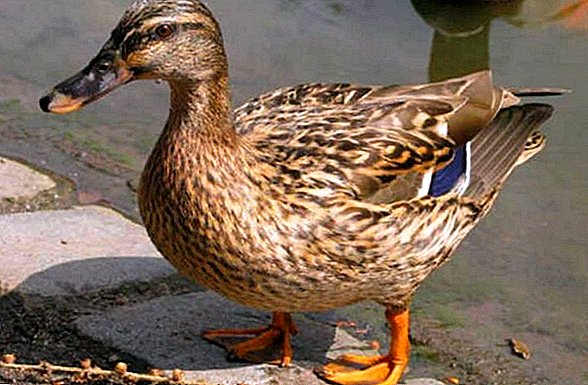 A short head with a wide concave beak is placed on a short neck. Wings tightly adjacent to the body. The plumage is painted in two colors: black and white and khaki.
A short head with a wide concave beak is placed on a short neck. Wings tightly adjacent to the body. The plumage is painted in two colors: black and white and khaki.
The mass of adult drakes is 4 kg. Clean meat in them 70%. The meat is tender, there is no specific taste in it. Efficiency in terms of eggs is 238 pieces for 280 days. The mass of each is approximately 90 g.
Puberty in ducks occurs at 4 months of age. At the same age, the birds reach the peak of their weight. Feed consumption per 1 individual - 2.73 units.
Breed advantages:
- high hatchability of young stock - about 80%;
- good immune system;
- the ability to easily adapt to living in any conditions;
- unpretentiousness to feed and special care;
- quick weight gain;
- low feed costs;
- small amount of fat.
 Disadvantages:
Disadvantages:- the availability of clean drinking water;
- frequent feeding due to increased appetite;
- reduced egg production in individuals with khaki plumage.
Did you know? Despite its short size, there are approximately as many vertebrae in the neck of the duck as in the neck of the giraffe. They are just very small in size.
Peking duck
Bird with a powerful elongated body. It has a large head, a thick arched neck, a bulging beak, a wide chest, and thick orange limbs. The wings are strong, tightly adjacent to the body. Tail raised. White plumage.
Drakes reach a mass of 3.6-4.2 kg, ducks - 3.4-3.9 kg. The onset of egg production accounts for 5-5.5 months. Its maximum level is 140 eggs per year. The mass of each - 85-90 g.  Advantages:
Advantages:
- long period of high egg production;
- good adaptation to cold conditions;
- unpretentious care;
- no need for a nearby reservoir.
We recommend reading about how long the duck is sitting on the eggs for finding out why the duck is swimming in the water, how to keep chickens and ducks correctly, how to properly trim the wings of ducks.
Disadvantages:
- easily excitable nervous system and restless temper;
- lack of instinct incubation;
- frequent diseases under abnormal conditions and raw chicken house.

Mulard
They are hybrids, bred from several breeds: musk drakes and Bashkir, Peking, Rouen ducks, White al, Orgington. The birds are well built. Their bodies are oblong, the head is medium in size, the neck is long, the legs are short.
Drakes gain weight from 4 to 7 kg, ducks - 0.5 kg lighter. Already in 3 months the bird reaches impressive sizes - about 4 kg. The mass of the liver in the drakes is 0.5-0.55 kg. Egg production starts in 180-210 days. Per day, mulardy consume about 340 g of feed.
Advantages:
- tasty and high-quality meat with a minimum amount of fat at the level of 3%;
- cleanliness;
- calm temper;
- early onset of egg production;
- unpretentious care;
- high productivity;
- Liver value for culinary specialists as a product for foie gras.
 Disadvantages:
Disadvantages:- inability to give birth;
- instability to dampness.
Did you know? There are no nerve endings on the paws of the ducks, so it can easily walk on a hot or icy surface without feeling discomfort.
Favorite blue
A bird with a dense constitution, a convex chest, widely spaced limbs. Beak and paws with a bluish tint. Plumage ashen, blue, blue.
Drakes reach a weight of 5 kg, ducks - 4 kg. With high-quality feeding, drakes can eat up to 8 kg, females - up to 6 kg. The meat is tasty, without a characteristic smell and taste. There is little fat in it. Egg production is 100-150 eggs per year weighing 80-85 g.  Advantages:
Advantages:
- successful acclimatization in various regions;
- unpretentious content;
- earliness - by the age of five months they reach the weight of a mature bird;
- tasty, high-quality meat with low fat content;
- decorative plumage.
Gray ukrainian
These are birds with a slightly raised body, wide belly, medium length wings, adjacent to the body, head extended, strong beak and thick neck. The plumage is painted gray with a white stripe on the neck.
Learn more about how to feed the little ducklings and ducks, as well as how to make feed for ducks with your own hands.
Drakes gain weight up to 3.5 kg, females - up to 3 kg. The meat of these birds is tasty, non-greasy. One individual brings from 120 to 140 eggs per year. And under excellent conditions of keeping the ducks hatched and over 200 eggs.  Advantages:
Advantages:
- endurance;
- unpretentiousness;
- good immunity;
- high quality meat;
- combined focus of productivity;
- good adaptation to winter temperatures.
Meat-egg, or egg-meat
The best meat and egg breeds are:
- Khaki Campbell;
- Cayuga;
- Saxon;
- Mirror;
- Orpington.
Khaki Campbell
A small bird with an oblong body and deep chest.  The head is small in size, located on a thin short neck. The wings are short, underdeveloped. The neck and back are brown, all other parts of the body are khaki.
The head is small in size, located on a thin short neck. The wings are short, underdeveloped. The neck and back are brown, all other parts of the body are khaki.
Drakes weigh 3 kg, females 2.5 kg each. The meat yield is about 90%. Egg production - 350 pieces per year. The mass of one egg is 80 g.
Advantages:
- high egg production rates;
- well-developed incubation instinct;
- excellent taste of meat;
- low percentage of fat;
- calm temper, non-conflict;
- ability to adapt to living in any conditions.
- poorly developed wings and virtually no ability to fly;
- poorly developed instinct nasizhivaniya.

Cayuga
Large-sized birds with an elongated broad body, a small oblong head, high forehead and a wide powerful beak. The body is covered with black plumage with a green metallic sheen. In the dark colors painted limbs and beak. The wings are long, well adjacent to the body.
We advise you to read more about the breeding of duck breed kayuga.
Drakes gain a mass of 4 kg, ducks - 3.5 kg. Slaughter for meat is produced at the age of two months. In the year one female is able to bring from 100 to 150 eggs weighing 80-100 g. The shell of the eggs is black.
Advantages:
- good instinct nasizhivaniya;
- high adaptation to any weather conditions and climate;
- excellent egg production;
- high quality meat;
- calm, quiet temper;
- decorative plumage;
- picky in feed and care.
 Among the shortcomings: for maximum productivity, birds need daily walking, even in winter.
Among the shortcomings: for maximum productivity, birds need daily walking, even in winter.Did you know? When flying to warm countries, ducks can rise to a height of 9 km and dive under water to search for food to a depth of 6 m.
Saxon duck
Birds have a small compact body, which is slightly directed upwards. The plumage of drakes and females varies in color. In men, it is generally orange with red, the head, neck, and wings are blue with a metallic sheen. On the neck they have a white horizontal strip. The females are colored brown with yellow tones.
The productivity of Saxon ducks: the maximum mass of the drakes - 3 kg, females - 2.5, the average annual egg production - 200 pieces weighing 75-80 g. 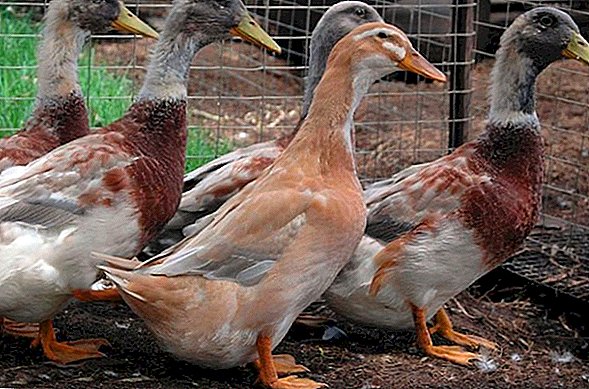 Advantages:
Advantages:
- good productivity;
- good survival of young;
- quality meat;
- decorative plumage;
- peaceful nature;
- endurance.
Mirror duck
The breed was bred by crossing Peking duck meat and meat-and-egg Khaki Campbell. These are birds with a strong build, a long and wide body. Their head is small, located on the average length of the neck. The body is covered with light brown plumage. Bill is dark gray, limbs are orange.
Learn more about the beneficial properties of duck meat, fat and eggs.
Males have a blue-green head and neck. On average, mirror ducks reach masses from 2.8 to 3.8 kg. One individual hatches about 150 eggs per year.  Advantages:
Advantages:
- early maturity;
- good endurance;
- good productivity;
- excellent safety of ducklings - up to 95%;
- high quality meat;
- good egg production;
- beautiful appearance.
Important! For the high productivity of most breeds of domestic ducks, they need to provide 4 important conditions: a warm poultry house, in which sanitary and hygienic standards are observed, a reservoir, a balanced diet, fresh, clean water.
Orpington
Bred by crossing several breeds: Eilsbury, Cayuga, Indian Runner.  Representatives of the breed have a strong and broad body, broad chest, elongated neck, small head. Their color is fawn or yellow with red.
Representatives of the breed have a strong and broad body, broad chest, elongated neck, small head. Their color is fawn or yellow with red.
The average weight of one individual female is 2.7-3.3 kg, male - 2.8-3.6 kg. The level of egg production is high - 140-160 pieces.
Advantages:
- high meat quality;
- high egg production;
- precocity.
Disadvantages - carelessness when eating food.
Yaytsenoskie
In order to get the largest possible eggs, the Indian runner is most often bred. This is a bird with an elongated body, with a vertical orientation, a rounded chest. She has a medium-sized head, an elongated neck, strong limbs that allow her to quickly and confidently run and swim.  Plumage is a different color. The most common - light shades of brown. The productivity of Indian runners - 350 eggs weighing 80 g. Mature individuals weigh about 2 kg.
Plumage is a different color. The most common - light shades of brown. The productivity of Indian runners - 350 eggs weighing 80 g. Mature individuals weigh about 2 kg.
Advantages:
- calm temperament;
- high egg production;
- strong immune system;
- good adaptability to environmental conditions, including cold;
- precocity.
Disadvantages - excessive fearfulness.
Wild duck species
About 120 species of ducks live in the wild. Among them are those that stand out with an interesting and unusual color of plumage, body structure, beak, and sounds. 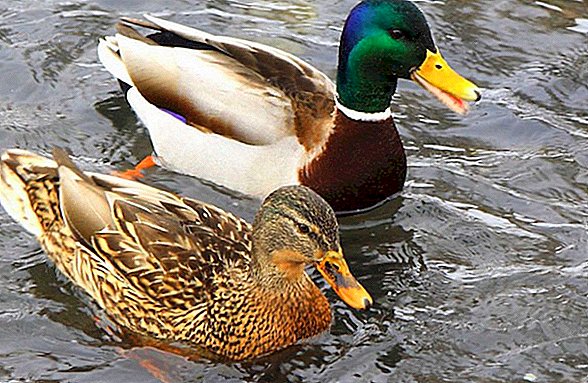 Wild ducks, as a rule, have wide and short wings, with the help of which it is good to dive, as well as limbs with three front fingers connected by membranes. They are small in size. Sexual dimorphism is usually clearly expressed in the color of plumage - the males are painted in more attractive beautiful colors before the molt.
Wild ducks, as a rule, have wide and short wings, with the help of which it is good to dive, as well as limbs with three front fingers connected by membranes. They are small in size. Sexual dimorphism is usually clearly expressed in the color of plumage - the males are painted in more attractive beautiful colors before the molt.
Wild ducks can also be kept at home. However, they will need to prepare a special diet - the one they eat in the wild: for example, river greens, algae, etc.
You will probably be interested to read about how to breed wild ducks, as well as how to make a diet for wild ducks.
River species
River species differ from others in that when they dive for food, they do not immerse themselves in water completely, but only slightly dip into it. Live most often in shallow water with abundant vegetation.
- The most common among river species - mallards. These are large birds weighing about 2 kg with large heads, short tail, flat beak. The color of the female individual is unremarkable - brown with dark spots.
 The male is handsome - with a green shiny head and neck, brown-brown chest, gray back and peritoneum. Lives in reservoirs with fresh or slightly brackish water.
The male is handsome - with a green shiny head and neck, brown-brown chest, gray back and peritoneum. Lives in reservoirs with fresh or slightly brackish water. - Another common river species is gray duck. She lives in the steppe and forest-steppe areas of Eurasia and North America. In appearance it is very similar to the mallard. However, gray drake does not have such a bright plumage. Also, representatives of this species more elegant physique. Weight of waterfowl - 0.6-1.3 kg - males, 0.5-1 kg - females.

- Also the smallest member of the duck family belongs to the river - teal whistle. The weight of females reaches 200-400 g, males - 50 g more. The distinctive external features of the teal-whistle are short neck and narrow wings. The main color of the male plumage is gray. Some parts of the body are painted in bright colors. The female is brown-gray. Teals live in shallow water, in the forest tundra, tundra, forest-steppe.

Krohali
Crohals have a long, cylinder-shaped beak with sharp teeth at the ends and a long body and neck.
It will be useful for you to read about how to make a barn for ducks with your own hands, and also whether you can keep chickens and ducks in the same room.
There are three types of krokhaley:
- big;
- average;
- scaly.
Representatives of the first mainly live in the forests. They have small body size - up to 70 cm in length and 1.5 kg in weight. There are various shades in body color - there are black, white, brown, orange colors. On the small head is a log.  The average merganser also lives in the forest zone. In the drakes, the body length is 60 cm, in females it is 55. The mass of mature ducks is 1 kg. Their crest is on the back of the head.
The average merganser also lives in the forest zone. In the drakes, the body length is 60 cm, in females it is 55. The mass of mature ducks is 1 kg. Their crest is on the back of the head.
Scaly merganser is quite rare. In appearance, it is similar to the average kohalya. However, it has a smaller size - 40 cm in length and 0.5 kg in weight. On the head of the females is a large crest.
Diving
As the name implies, these birds get their food by diving under water. This species is most common in the Northern Hemisphere. Most of these ducks are found in North America. In diving there are several species. The most common among them - dives, black, marble teal.
- Diving - medium in size and weight, the adult weighs about 0.9 kg. They have a big head and a short neck. The plumage is colored depending on which species the duck belongs. Like almost all wild ducks, males look very beautiful - their heads are painted in bright colors. Diving habitat is a temperate climate zone.
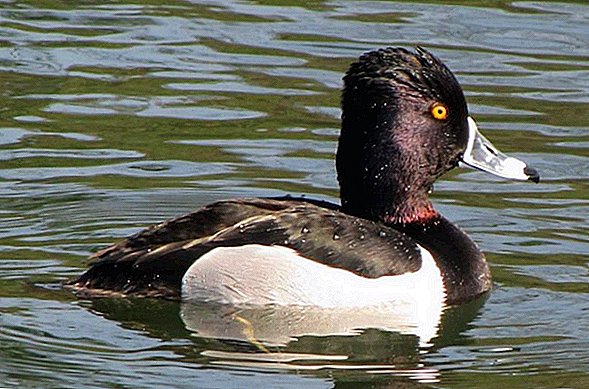
- Cherneti very similar to diving. Their body is compact, but chunky. The head is large, located on the short neck. The bill is black or gray. On the wings are light stripes. In black duck many varieties are distinguished, which differ in the color of their plumage.

- Marbled Teal - This is one of the few wild ducks, in which both the male and the female have the same feather color - brown with gray and dark spots. They are small in size and weight - weigh about 0.6 kg. Found in Asia, Europe, India, Russia.

Important! Hunters love to hunt wild representatives of ducks. However, it is important to comply with the legislation that regulates hunting, not to violate the allowed terms, not to poach. Each hunter’s duty is also to take measures to create favorable conditions for the life and breeding of birds.
Indeodine Musk Ducks
Quite often today in the farm you can find not only ordinary ducks, but also indoutok. These are large massive birds with dark plumage and white areas. They were bred in Mexico and South America, and later became popular in other countries. Their other name is musky, which they received allegedly because of the musky smell of fat.
The length of domestic male Indo-ducks reaches 90 cm, weight - 4-6 kg. The body of the females is shorter - 65 cm, their weight is 2-3 kg. Intoys with large, elongated head with characteristic fleshy growths of red.  These birds do not differ precocity. Their average egg production is from 70 to 120 eggs per year. They have a good incubation instinct, thanks to which they are used to incubate not only duck eggs, but other species of birds.
These birds do not differ precocity. Their average egg production is from 70 to 120 eggs per year. They have a good incubation instinct, thanks to which they are used to incubate not only duck eggs, but other species of birds.
Read more about breeding, incubating and feeding musk ducks, as well as how to properly equip a room for growing indouka, why don’t rush about indouka, whether it is possible to eat indoutok eggs and when to cut them for meat.
One of the main values of musk ducks is tasty and lean meat. It is far superior in quality to other domestic duck breeds. In Indo-ducks there are several varieties depending on the color of the feathers, legs and beak.
Basic breeds:
- white - with white feathers, pink beak and yellow legs;
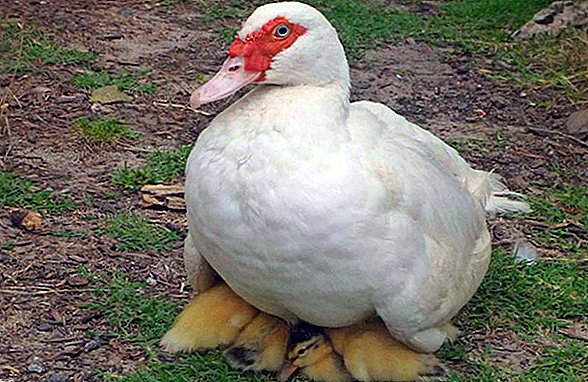
- black - has a black plumage with a purple tint, beak and legs are black;
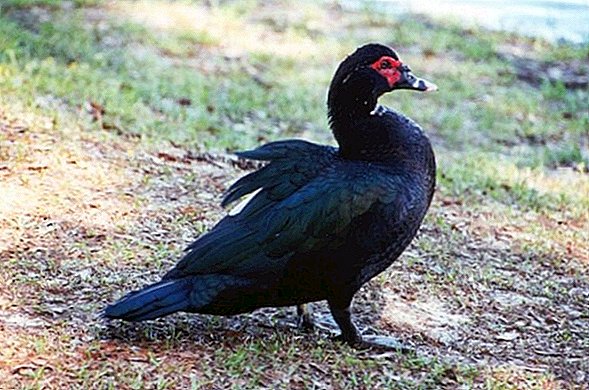
- black and white - the main color is black with a purple tint, the chest is white-black, the paws are yellow, the beak is pink;

- brown and white - the body is covered with chocolate feathers with a green tint, on the head and chest there are white feathers, the beak is red, the legs are gray;

- blue - has a completely blue body with a dark edging on the wings and a black beak.

So, there are a lot of breeds of both domestic and wild ducks. Domestic choose in the economy, depending on their direction of productivity: meat, meat, egg, egg.
Wild ducks are also divided into several species: river, merganser, diving and others. Indo-ducks or musk ducks are distinguished as a separate group. Each breed has its own characteristics, advantages and disadvantages, as well as requirements for living conditions.


 The male is handsome - with a green shiny head and neck, brown-brown chest, gray back and peritoneum. Lives in reservoirs with fresh or slightly brackish water.
The male is handsome - with a green shiny head and neck, brown-brown chest, gray back and peritoneum. Lives in reservoirs with fresh or slightly brackish water.









